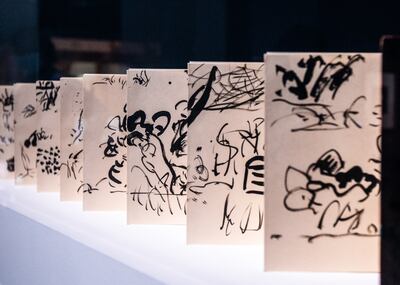Louvre Abu Dhabi’s new exhibition is an homage to one of humanity’s most transformative breakthroughs: paper.
The museum has often presented works that reflect on historical cross-cultural interaction through a civilisational lens, but Stories of Paper marks a rare time that a single material takes centre stage to tell that story.
More than 100 paper-based objects from across the globe are on display at the exhibition. Together, they trace two millennia of intellectual, scientific and cultural exchange. The works are sourced from 16 museums, cultural institutions and private collections.
Works include Katsushika Hokusai’s renowned The Great Wave off Kanagawa, one of Louvre Abu Dhabi’s latest acquisitions and on display at the museum for the first time, as well as a 15th century Quran from Tunisia, scribed with silver ink on purple-dyed pages.
The exhibition is curated by the Musee du Louvre’s Xavier Salmon, general curator and director of the Department of Drawings and Prints, and Victor Hundsbuckler, curator at the Department of Drawings and Prints, with the support of Souraya Noujaim, director of Scientific, Curatorial and Collections Management at Louvre Abu Dhabi.

“With the emergence of digital transformation and the dematerialisation of our haptic experiences, it makes sense for Louvre Abu Dhabi, a universal museum, to celebrate paper as a common yet precious good,” says Manuel Rabate, director of Louvre Abu Dhabi.
"From books, manuscripts and drawings to contemporary artworks or installations made of paper, Stories of Paper retraces a chronological history of this single universal medium, considering the usage and key characteristics of paper, such as transparency and robustness to provide an original perspective on the use of paper throughout time and across the different regions.
"We are also very pleased to invite prominent Emirati artists to be to be part of this shared dialogue — with works on display by Hassan Sharif, Abdullah Al Saadi and Mohammed Kazem, all of whom are considered pioneers of Emirati conceptual art.”
A snaking arrangement of paper banners guide the exhibition, which is divided into 12 sections. The sections, nor the objects they exhibit, are arranged in chronological order. The paper banners, however, offer a historical and chronological thread to the show. Printed with text, they trace the history of paper, from its discovery in China somewhere around the 2nd century BCE, to its first fabrication in Damascus in the late 10th century. From the first use of watermark sheets in 1282, to Gutenberg’s printing of the Bible in the 15th century and beyond.
Sketches by Baroque-era French artists such as Philippe de Champaigne occupy the same area as Etel Adnan’s unpaginated fold-out The Sausalito Garden from 1996. Shoes and hats made out of Korean traditional paper during the 15th century Joseon dynasty are exhibited perpendicularly to the 2015 installation Dictionary by the late Sharif.
Yet, it doesn’t feel dizzying.
The exhibition is arranged thematically, highlighting different aspects of paper, including its versatility and its influence as an affordable material. While singular works may shine and command attention, the real star of the show, in its curation and sweeping timeline, is always the material itself.

Stories of Paper begins by paying tribute to the plants behind the material, showcasing the different production techniques developed across the world.
“You have a comparison of the way to do paper in Asia and in Europe,” says Salmon. “Paper first appeared in Asia and after it moved towards the West, first in the Islamic World, where it arrived via the Silk Road and then to Spain, to France and Italy.
“The difference is that in Asia, they worked directly with the plant. In the Islamic world and the occidental world, we worked with old linen cloths.”

While historical books, manuscripts and drawings are replete in the exhibition — not to mention a full-scale model of a traditional Korean house interior, made using traditional Korean paper — there are also 13 contemporary artworks, most of which are displayed in a boxed recess. Sharif’s The Dictionary is presented in its original form. A vertical oblong mass of pages from bilingual English-Arabic dictionaries held together by rope, the installation sits in one of the most esteemed spots in the exhibition, and captures attention right away.
A total of 16 museums, cultural institutions and private collections will be on display. These include books, manuscripts, drawings, a reproduction of a house and 13 contemporary artworks and installations made of paper. The exhibition will take visitors on a journey through time to discover the various ways in which paper was utilised across cultures. Visitors will also be able to enjoy a diverse public programme of wide-ranging cultural activities.
“The artwork is from one of the pioneers of contemporary art in the UAE,” says Amna Rashed Al Zaabi, senior curatorial assistant at the Louvre Abu Dhabi, who helped curate Stories of Paper.
“The artist used seven bilingual dictionaries to create the work. He deconstructed them and attached the pages to ropes. The work was inspired from memories the late artist had while studying in the College of Arts in London, where he had to learn English.”
A rich cultural and educational programme will accompany Stories of Paper, offering an array of events. An online talk and a recorded podcast by the exhibition’s curators will be available on Louvre Abu Dhabi’s website and mobile application.
The accompanying publication of Stories of Paper is in itself an art piece. With exposed spines and an ochre-coloured cover inspired by the country’s sands, the book is printed using several kinds of paper and expands on works from the exhibition.
“We were thinking we don't have the traditional catalogue, but we wanted a special book with special paper so you have different kinds of paper inside,” Salmon says. “It’s a very special book, like the exhibition, and is an homage to a fantastic material.”














